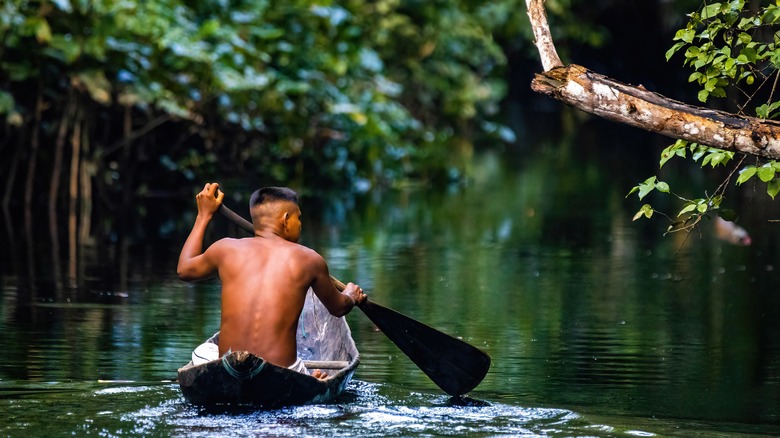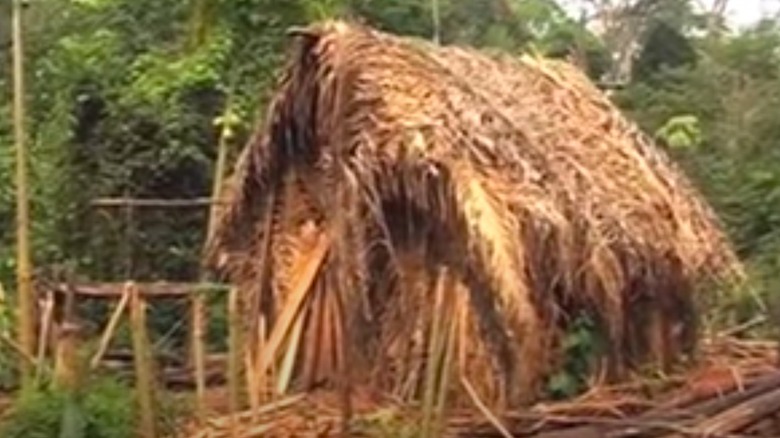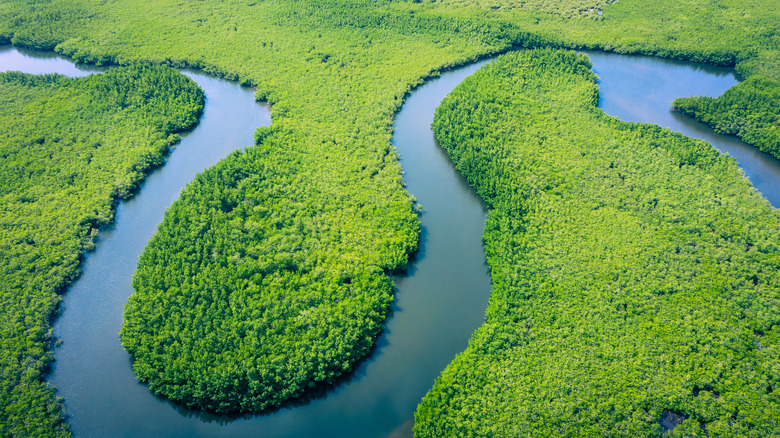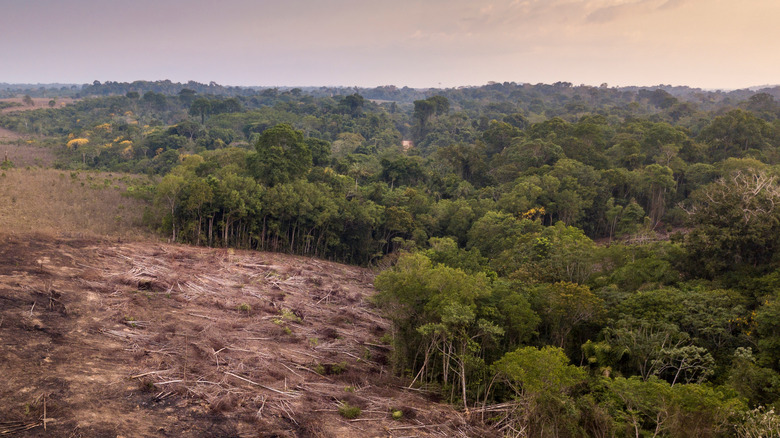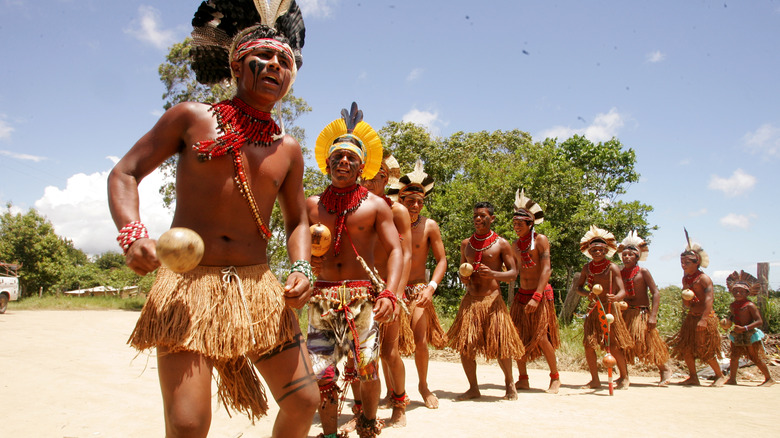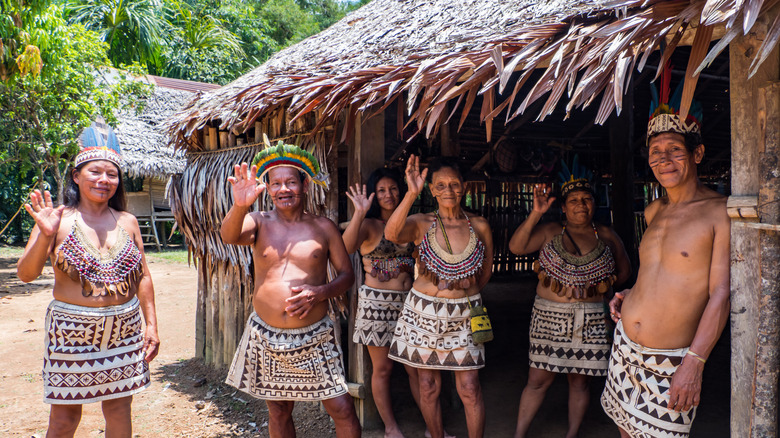The Mysterious Man Of The Hole Explained
When colonizers first arrived in Brazil, there were around 2,000 distinct tribes in the area, per Survival International. Now, hundreds of years later, there are about 240 indigenous tribes (via Yahoo). And in August 2022, the last member of a tribe living in the Tanaru indigenous area died.
The man, also known as the "Man of the Hole," has been living alone in the Amazon for the last 26 years, hunting, setting traps, gathering, and growing food in order to sustain himself. Indigenous protection officials had initially attempted to reach out to the unnamed man, but after being met with volleys of arrows, they eventually decided to leave him to himself in 2005 (via Live Science). Still, they continued to observe the man from a distance, checking up on him and his territory, which is how they discovered his body in a hammock near one of his straw huts. The man, who was covered in feathers when he was discovered, had probably been dead for one or two months before he was found.
Who was the Man of the Hole?
The Man of the Hole acquired his name because of his hunting habits. According to Yahoo, the man frequently dug very deep holes in his territory, as deep as 10 feet each. The man also built more than 50 straw huts for himself, but the holes — in which the man placed spikes — drew the most attention. They were thought to potentially be traps designed for hunting, but there are other theories as to their purpose, as well. Some people believe that the holes were intended to be a way for the man to hide from anyone who came into his territory. Still, other theories behind the holes hold that they could be spiritually significant. Notably, the holes were not just dug in the forest — there were also holes dug in the man's huts (above), suggesting that there was perhaps a greater purpose for them beyond hunting.
Authorities took videos of the man that have also shown him using tools, like axes, to cut down trees (per CNN).
What is known about the man's tribe?
For decades, the Man of the Hole was known to be the last member of his tribe. But how did this come to be the case? Back in the 1970s, there was a more substantial group of individuals that made up the tribe, per Yahoo. But things went wrong in a clash with cattle ranchers, and many of these individuals were killed. Then, just a couple of decades later, nearly the entire rest of the tribe was killed, this time during a confrontation with illegal miners in the area. Of the seven remaining members of the tribe, all but one were killed — the Man of the Hole.
Since then, the authorities have not been able to contact the Man of the Hole to discuss his background with them. That means a lot remains unknown about the Man of the Hole, including his name, the language he spoke, and the precise tribe he belonged to.
How the Man of the Hole died
Given the Man of the Hole's background, you might expect that he also died from a clash with outsiders. In fact, these types of clashes are relatively common with the locals, per Yahoo. Farmers and cattle ranchers seeking an expansion of their lands often want an excuse to be able to encroach on indigenous regions, and without the protection of the Brazilian government, violent interactions can occur.
The Man of the Hole's lands, the Tanaru land, is near cattle ranching territory, per Survival International. However, despite the risk and what some advocacy groups call an ongoing genocide against indigenous peoples in Brazil (via CNN), there is currently no evidence that foul play was involved in the Man of the Hole's death. Instead, he appears to have died at approximately age 60 of natural causes, according to Yahoo. Still, the Brazilian government will investigate the scenario further and conduct a forensic examination of the body.
When the death of the Man of the Hole was announced, the Brazil National Indian Foundation, or FUNAI, shared a statement, saying they felt "immense regret" about his death (per the New York Post).
Other uncontacted indigenous tribes
While the Man of the Hole received particularly high-profile coverage internationally — even being called the "most isolated man on the planet," per World Atlas — he is far from the only uncontacted indigenous person in the world. In fact, there are some 100 uncontacted indigenous tribes in the world. Many of these tribes are located in the Amazon, but others can be found on islands or in other forested regions.
Many uncontacted indigenous tribes may simply not have any desire to interact with other peoples. But there are also very real threats faced by indigenous tribes, and a lack of contact can help protect them from such dangers. For instance, many individuals — including the Man of the Hole himself — may avoid contact because their previous interactions with others have been dangerous (via CBC). Other risks include threats of foreign disease, which can be detrimental to groups with no previous exposure to said illnesses (per Live Science).
The last member of a tribe
There have been other individuals who have been the "last of their tribe," too. In 1911, a man named Ishi came forward as the last member of the Native American Yahia tribe, according to World Atlas. In a parallel story to the Man of the Hole, Ishi had been living with the other remaining members of his tribe when they were attacked by settlers, and they were all killed. Only Ishi survived. The massacre was the culmination of decades of attacks on Ishi's California-based tribe that killed large numbers of people, according to the University of California at San Francisco.
But unlike the Man of the Hole, Ishi, despite his best efforts, could not make it in total isolation. He was nearly starving when, three years after the deaths of his tribe, he appeared in California looking for help. Ishi ended up working closely with researchers and educating them on his tribe's practices, though he eventually died of tuberculosis less than five years after seeking out contact with California settlers.
